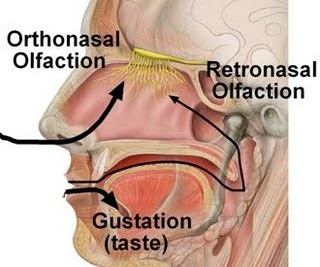Smells Like I Am Full
Tuesday, December 22, 2009 An important aspect of enjoying food, in addition to the actual taste and mouth feel, is the complex sensory stimulation of the olfaction system. After the food enters the oral cavity, aroma molecules find their way to the sensitive olfactory nerve endings in the nose by making their way up the back of the throat into the nasal cavity (apparently the nose has a clever way of telling whether this aroma is coming from the food on your plate or from the food in your mouth).
An important aspect of enjoying food, in addition to the actual taste and mouth feel, is the complex sensory stimulation of the olfaction system. After the food enters the oral cavity, aroma molecules find their way to the sensitive olfactory nerve endings in the nose by making their way up the back of the throat into the nasal cavity (apparently the nose has a clever way of telling whether this aroma is coming from the food on your plate or from the food in your mouth).
This activation of specific brain areas by a retronasally sensed food odor is not only associated with the perception of the aroma of the food that is consumed but is also hypothesized to directly contribute to its satiating effect (sensory-related satiation).
A paper by Rianne Ruijschop and colleagues from The Netherlands, published in the Journal of Agricultural and Food Chemistry, provides a splendid overview of this fascinating area of research.
In this paper, Ruijschop and colleagues describe a series of experiments that examine a wide range of factors that can affect retronasal olfaction-related satiation.
Not surprisingly, solid and semisolid foods that required a greater amount of chewing and swallowing elicited a stronger and longer-lasting retronasal aroma release pattern than the rather short-lived spiked pattern observed with liquid foods. A higher extent of retronasal aroma release may therefore be one of the explanations why solid foods appear to be more satiating than liquid foods.
Indeed, the researchers did observe a negative trend between the extent of retronasal aroma release and the amount of ad libitum food intake. Subjects who had a higher extent of retronasal aroma release tended to consume less.
However, retronasal aroma release intensity and profile morphology appeared to be subject specific, which may support the hypothesis that subject differences in the extent of retronasal aroma release are linked to subject differences in sensory satiation and food intake behavior.
In further studies, the researchers found that certain aromas were better at eliciting a satiation response than others. Thus, aromas that suggest fat content (i.e., lactones) were less effective in creating a satiation response than aromas suggesting carbohydrate content (i.e., maltol) or the breakdown of protein (i.e., “animalic”). In a separate experiment, custard products with the addition of maltol or animalic at sensory detection threshold were able to increase subjects’ feeling of fullness significantly.
These results are in line with the observation that macronutrients have different satiating efficiencies, in which protein is more satiating, followed by carbohydrate and fat as least satiating.
Based on these studies, the authors suggest that these findings may provide the rational for developing strategies for prolonging the duration of retronasal aroma release during food consumption.
Examples could include food products with an increase of aftertaste or an increased or lingering aroma release via flavor delivery systems or encapsulation technology or the development of long-chewable food structures in beverages that evoke substantially more oral processing and an increase in transit time in the oral cavity.
Furthermore, a reduction in bite size by tailored packaging may support the “right” oral processing behavior in food products. Interestingly, as blogged previously, eating too fast has been previously associated with increased risk for obesity.
Differences in the extent of retronasal aroma release during consumption may be one of the reasons that people vary in their satiation characteristics, which may prevent them from overeating or not. Whether or not there is a difference in this effect between normal weight and obese people is not known.
As the authors point out, integration of these findings into novel food products may provide a new way to reduce food consumption.
While we wait for these new foods here are my retronasal olfaction-based satiation tips:
1) Take small bites
2) Chew your food thoroughly
3) Don’t drink your calories
Remember, the main problem with fast food is not the “food” – it’s the “fast”.
Happy Holidays,
AMS
p.s. As I am planning to take it easy for the next couple of days you are likely to see sporadic posts till the new year.


